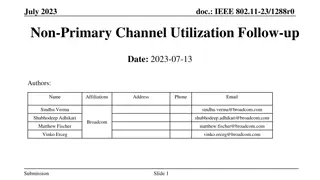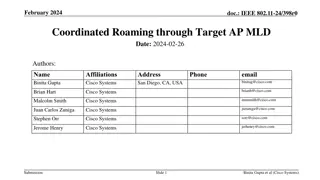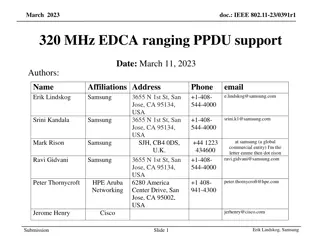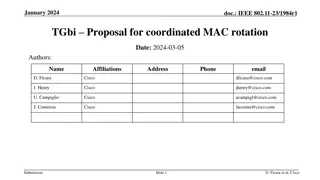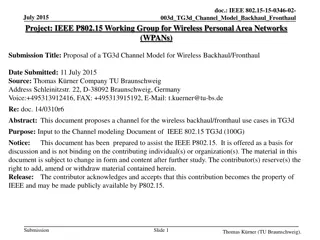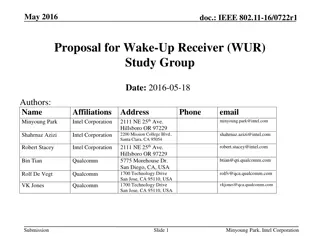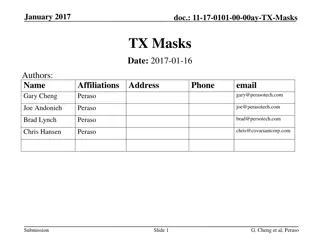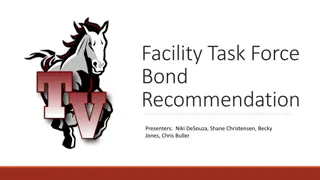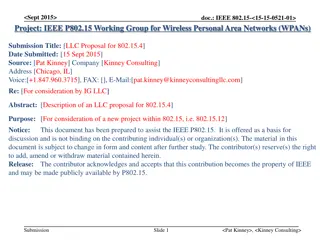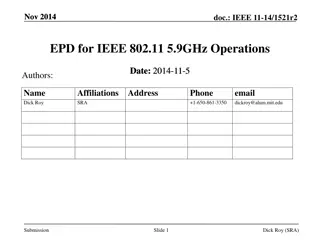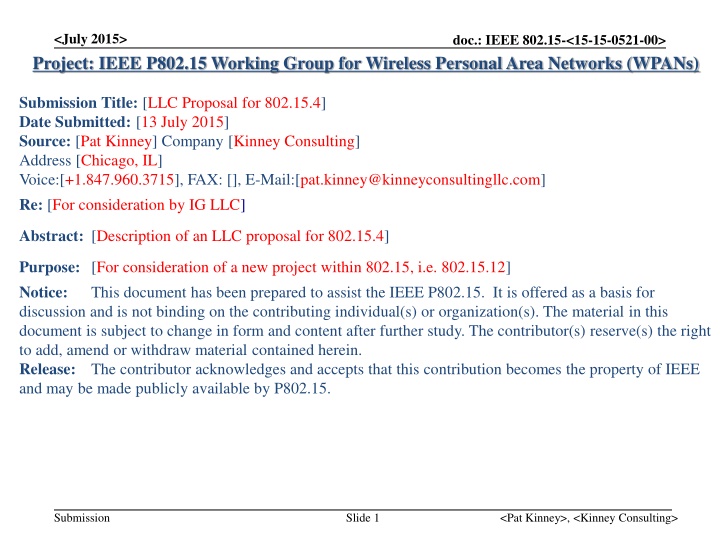
IEEE 802.15.12 LLC Proposal for Wireless Networks
"Explore the proposal for a new IEEE 802.15.12 Logical Link Control (LLC) standard to enhance the usability and compatibility of IEEE 802.15.4 in various applications like IIoT, Smart Grid, and IoT, while maintaining backward compatibility. The document details the conceptual overview, targeted applications, and benefits of this new standards project."
Download Presentation

Please find below an Image/Link to download the presentation.
The content on the website is provided AS IS for your information and personal use only. It may not be sold, licensed, or shared on other websites without obtaining consent from the author. If you encounter any issues during the download, it is possible that the publisher has removed the file from their server.
You are allowed to download the files provided on this website for personal or commercial use, subject to the condition that they are used lawfully. All files are the property of their respective owners.
The content on the website is provided AS IS for your information and personal use only. It may not be sold, licensed, or shared on other websites without obtaining consent from the author.
E N D
Presentation Transcript
<July 2015> Project: IEEE P802.15 Working Group for Wireless Personal Area Networks (WPANs) doc.: IEEE 802.15-<15-15-0521-00> Submission Title: [LLC Proposal for 802.15.4] Date Submitted: [13 July 2015] Source: [Pat Kinney] Company [Kinney Consulting] Address [Chicago, IL] Voice:[+1.847.960.3715], FAX: [], E-Mail:[pat.kinney@kinneyconsultingllc.com] Re: [For consideration by IG LLC] Abstract: [Description of an LLC proposal for 802.15.4] Purpose: [For consideration of a new project within 802.15, i.e. 802.15.12] Notice: This document has been prepared to assist the IEEE P802.15. It is offered as a basis for discussion and is not binding on the contributing individual(s) or organization(s). The material in this document is subject to change in form and content after further study. The contributor(s) reserve(s) the right to add, amend or withdraw material contained herein. Release: The contributor acknowledges and accepts that this contribution becomes the property of IEEE and may be made publicly available by P802.15. Submission Slide 1 <Pat Kinney>, <Kinney Consulting>
<July 2015> doc.: IEEE 802.15-<15-15-0521-00> Proposal of a new LLC specifically for IEEE 802.15.4 A new standards project focused on IEEE 802.15.4 Submission Slide 2 <Pat Kinney>, <Kinney Consulting>
<July 2015> doc.: IEEE 802.15-<15-15-0521-00> IEEE 802.15.12 Logical Link Control (LLC) A new IEEE 802.15 project is being conceived to: Make IEEE 802.15.4 easier to use, like IEEE 802.11 (WiFi) and IEEE 802.3 (Ethernet) Enable IEEE 802.15.4 to use many of the higher layer protocol stacks used by IEEE 802.11 and IEEE 802.3 without changes Allow IEEE 802.15.4 to address new applications yet maintain backward compatibility with existing devices and applications Submission Slide 3 <Pat Kinney>, <Kinney Consulting>
<July 2015> doc.: IEEE 802.15-<15-15-0521-00> Target Applications for 802.15.12 Deterministic ISA100.11a IETF 6tisch Industrial Internet of Things (IIoT) Non-Deterministic (best effort) Smart Grid (e.g. WiSUN Internet of Things (e.g. IoT) Long Range Infrastructure (e.g. LECIM, LoRA , SigFox ) , etc.) Submission Slide 4 <Pat Kinney>, <Kinney Consulting>
<July 2015> doc.: IEEE 802.15-<15-15-0521-00> Table of Contents Conceptual Overview Background Issues General Benefits Set up behaviors Dynamic behaviors Emulations of L2 protocols for standards based upon 802.15.4 Submission Slide 5 <Pat Kinney>, <Kinney Consulting>
<July 2015> doc.: IEEE 802.15-<15-15-0521-00> General Concept Create a Data Link sublayer above the MAC that adapts and configures the 802.15.4 MAC for desired operation, and contains existing and soon to be released sub-layers for 802.15.4 such as 6LoWPAN, Key Management Protocol (KMP), Layer 2 Routing Mesh (L2R), 6top (IETF 6tisch) Submission Slide 6 <Pat Kinney>, <Kinney Consulting>
<July 2015> doc.: IEEE 802.15-<15-15-0521-00> Protocol Layers Transport Layer UDP, TCP, ICMP Network Layer IPv6 (IPv4 with adapter) Data Link Layer LLC (802.15.12) MAC (802.15.4) Physical Layer 802.15.4 Modulations: O-QPSK,BFSK, FSK, OFDM 802.15.4 Frequency Bands: (433, 890, 915, 2450, et al) Submission Slide 7 <Pat Kinney>, <Kinney Consulting>
<July 2015> doc.: IEEE 802.15-<15-15-0521-00> 802.15.12 LLC would contain: Key Management Protocol Layer 2 standard (IEEE 802.15.9) IPv6 network adaption standard for 802.15.4 (RFC 6775) KMP 6LoWPAN L2R 6top Part of IETF 6tisch standard for TSCH (deterministic behavior adapted from WHART and ISA100.11a) Layer 2 Mesh routing standard (IEEE 802.15.10) Submission Slide 8 <Pat Kinney>, <Kinney Consulting>
<July 2015> doc.: IEEE 802.15-<15-15-0521-00> 802.15.12 would also include Channel Configuration New features such as: - Duplicate frames detection - Priority operation - EtherType (indicates protocol) Security Configuration Information Element (IE) use -Standardized L2 data handling - Upper layer creation/use 802.15.4 MAC PAN Configuration Submission Slide 9 <Pat Kinney>, <Kinney Consulting>
<July 2015> doc.: IEEE 802.15-<15-15-0521-00> Background IEEE 802.15.4 s culture is to keep the MAC simple and the PHY simpler. Complex decisions determining MAC behaviors were passed to the next higher layer. For example: Should the node join a specific network? What short address should the coordinator allocate to a node? What data rates, modulations, et al should be used? The above culture resulted in 802.15.4 not being as easily used as 802.11 and 802.3, since the 802.15.4 higher layers must do many additional operations (which may be poorly described). Submission Slide 10 <Pat Kinney>, <Kinney Consulting>
<July 2015> doc.: IEEE 802.15-<15-15-0521-00> Issues Although IEEE 802.15.4 is extremely popular with vendors and users, each user application needs a specific protocol stack Older versions of 802.15.4 didn t address many of the new application needs, hence user application stacks added their own enhancements Security on older versions of 802.15.4 did not function correctly, hence user application stacks used their own security Submission Slide 11 <Pat Kinney>, <Kinney Consulting>
<July 2015> doc.: IEEE 802.15-<15-15-0521-00> Issues (continued) 802.15.4 couldn t optimally address application needs ranging from very small protocol code space to complicated protocol structures Different, often proprietary, protocols such as LoRa, SIGFOX, Thread, and Z-Wave have arisen due to the complexity of 802.15.4 protocols, misunderstanding of how to use specific 802.15.4 modes and the performance gains they can give. Submission Slide 12 <Pat Kinney>, <Kinney Consulting>
<July 2015> doc.: IEEE 802.15-<15-15-0521-00> 802.15.12 Benefits 802.15.12 will be able to configure the 802.15.4 MAC and PHY with security, network, and channel settings via defaults or settings received via an out-of-band means 802.15.12 will enable IC or stack vendors to provide consistent and standardized mechanisms to set up networks and links 802.15.12 will enable IEEE 802.15.4 to address new applications or to better address existing applications Submission Slide 13 <Pat Kinney>, <Kinney Consulting>
<July 2015> doc.: IEEE 802.15-<15-15-0521-00> Network Discovery and Selection Support Generic advertisement service (GAS) Functionality (borrowed from 802.11) enables nodes to discover the availability of information related to desired network services in a standardized fashion e.g., information about services such as provided in a WPAN, local access services, or other external networks Submission Slide 14 <Pat Kinney>, <Kinney Consulting>
<July 2015> doc.: IEEE 802.15-<15-15-0521-00> Network Setup PAN Coordinator default parameters Addressing PAN ID (or no PAN ID) Mode: Beacon-enabled or Nonbeacon-enabled Topology Mesh or Star Link set up channel(s), modulation parameters, data rate(s), transmit power(s), Low Energy mode(s), FCS size, CSMA settings Channel Hopping Network changing frequencies periodically Asymmetric Network devices are either high or low capability Submission Slide 15 <Pat Kinney>, <Kinney Consulting>
<July 2015> doc.: IEEE 802.15-<15-15-0521-00> Security Set-up Authentication and encryption Policy settings (network keys only or link keys, security level by frame type, by IE type, etc.) Key management protocol, such as 802.15.9 Authorization Submission Slide 16 <Pat Kinney>, <Kinney Consulting>
<July 2015> doc.: IEEE 802.15-<15-15-0521-00> Management Collection of network metrics Neighbor tables Information Elements Build IEs for transmission to other devices Decode IEs received from other devices Prepare IEs such as ESDUs intended for other device s higher layers Submission Slide 17 <Pat Kinney>, <Kinney Consulting>
<July 2015> doc.: IEEE 802.15-<15-15-0521-00> Regulatory Matters Country of operation Device class Duty cycle constraints CCA settings (time, threshold, mode) Submission Slide 18 <Pat Kinney>, <Kinney Consulting>
<July 2015> doc.: IEEE 802.15-<15-15-0521-00> Dynamic Behaviors Dynamic behaviors allow a network/device to adapt to changing conditions and maintain performance. IEEE 802.15.12 proposed dynamic behaviors include: Dynamic Data Rate Selection For those PHYs with multiple data rates, data rates could be better set by 802.15.12 on a link-by-link basis Dynamic Transmit Power Selection For PHYs with defined multiple transmit power levels, 802.15.12 could set transmit power level on a link-by-link basis considering CSMA impact, PHY Preambles, PHY FEC, signal strength, failed packets Dynamic Channel Selection For fixed frequency operation maintain current channel status such as coexistence issues and interferers and periodically search other channels for better link quality conditions and change to another channel if advantageous Dynamic Preamble Selection For PHYs with multiple preamble, 802.15.12 will configure the MAC to verify the preamble s effect on the link and then configure the MAC for the best preamble Dynamic Modulation Selection For PHYs with multiple modulation options 802.15.12 will configure the MAC to test modulation effectiveness and then configure the MAC for the best modulation Submission Slide 19 <Pat Kinney>, <Kinney Consulting>
<July 2015> doc.: IEEE 802.15-<15-15-0521-00> Emulation of standard s L2 protocols based upon 802.15.4 802.15.12 could be enhanced with further ISA100.11a behaviors since TSCH and IETF 6top have already been developed Others? Submission Slide 20 <Pat Kinney>, <Kinney Consulting>

